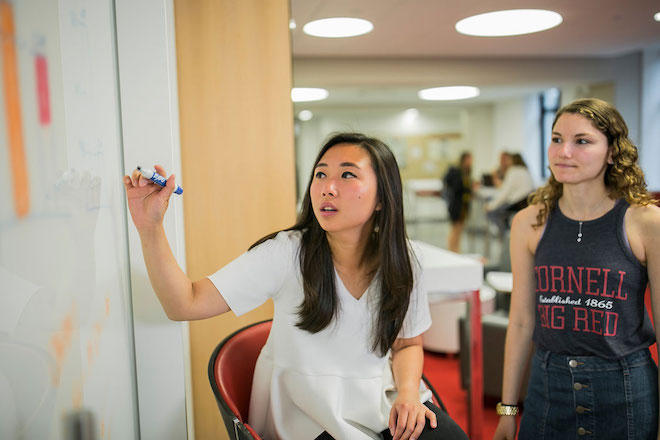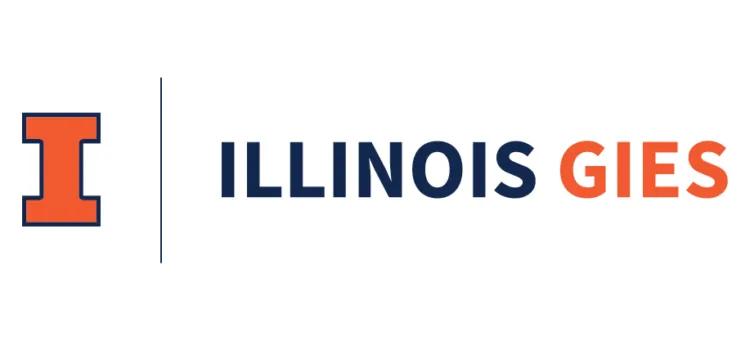
And the winner for hardest business school to get into goes to … Cornell’s Dyson School, which accepted fewer than 3% of applicants in 2018. Cornell photo
Last year, Dean Lynn Wooten attributed the stingy 2.93% acceptance rate at Cornell University’s Dyson School of Applied Economics and Management to the school’s expansion as part of the Johnson College of Business. She noted that on July 1, 2016, Cornell University launched the new college, uniting the university’s three AACSB-accredited business schools: The Hotel School, the Dyson School, and the Samuel Curtis Johnson Graduate School of Management.
Because of that change, the undergraduate B-school’s already miserly 7% acceptance rate plunged even further. “Once we actually became part of the College of Business,” Wooten told P&Q, “more students were able to actually find us and start to understand what the Dyson undergraduate business experience was like, and so last year we had a peak in applications.”
Well, another year has gone by, and that peak in apps hasn’t slowed much. In the fall of 2017, Cornell Dyson had 128 admits out of 4,366 applicants; this fall, the school had 4,164 applicants, out of which 122 were accepted, for a rate of 2.90%. You read that right — even though the apps dropped by about 5%, the Dyson School’s acceptance rate actually went down again this year because they admitted six fewer students.
What does Cornell Dyson look for in an applicant? It accepts either SAT or ACT scores. Academically, it is looking for students who have “taken the most rigorous courses available” and “performed well,” which includes seven total units of mathematics (including calculus) and science, with extra credit for additional studies in biology, chemistry, and physics. But it’s not enough to be book smart. Cornell wants “leaders, team players, creative thinkers, and self-starters” — after all, this is the Ivy League.
“If you realize there are only two Ivy League schools that have undergraduate business programs, and ours is so small, that’s why you see the heightened application activity and the smaller acceptance rate number,” Wooten said last year. Apparently that reality continues in 2018.
CORNELL: A CHANCE FOR ‘A RARE TRIFECTA’
Cornell Dyson is one of five schools with single-digit acceptance rates among the 88 in our third annual ranking. The others, in order, are: UC-Berkeley Haas School of Business (4.30%), the Wharton School at the University of Pennsylvania (6.49%), NYU Stern School of Business (8.00%), and Washington University in St. Louis Olin Business School (9.70%). These are the same five schools that were the most selective in last year’s ranking of 82 schools, though all five reduced their acceptance rates this year. (In fact, all of the top 17 schools this year saw their rates go down.) Berkeley Haas — a two-year program — sliced its rate in half, from 8.62%; NYU Stern dropped three percentage points, from 11%; and Washington Olin shaved off nearly two points, down from 11.48%. Wharton, the top school in our ranking last year and this year, had an acceptance rate of 7.1% in 2017.
“As one of only two Ivy League universities (the other being University of Pennsylvania) with an undergraduate business program, Cornell offers applicants the chance for a rare ‘trifecta’ — a highly marketable academic major, a prestigious brand, and an elite alumni network,” says Jennifer LaRusso-Leung, managing consultant for The MBA Exchange‘s undergraduate admissions practice AdvanceAdmissions. “This combination easily explains Cornell’s incredibly low acceptance rate.”
About UC-Berkeley Haas, she adds: “In addition to having a stellar academic reputation, Berkeley Haas offers the appeal and advantage of its geographic location. As one of only two undergrad business programs in California (the other being Santa Clara) included in last year’s Poets&Quants ranking of the top 50 programs, Haas is a strong first choice of technology-oriented applicants who want to earn a highly respected undergrad degree within driving distance of Silicon Valley.”
A LOOK AT THE MOST & LEAST EXCLUSIVE SCHOOLS
Last year, besides the top five, nine more schools had under 20% acceptance, and 25 schools total had under 25%. Fifty-one of the ranked schools — 62% — had acceptance rates below 50%. This year there are 15 schools below 20%, 26 schools at or below 25%, and 54 schools — 61% — at or below 50%. The average acceptance rate among all 88 schools for the entering Class of 2018 was 43.7%. Among the notables: SMU’s Cox School of Business, which reduced its acceptance rate from 12% to 11.12%; CMU Tepper, which dropped from 17.5% to 12%; and Michigan Ross, which fell from 18% to 12%. Virginia’s McIntire School of Commerce reduced its rate from 20.7% to 12.15%, and Northeastern’s D-Amore-McKim Business School dropped from 26.9% to 18.68%.
Not every school became more exclusive. UNC’s Kenan-Flagler Business School was the sixth-most selective school in 2017 with a rate of 11.6%; this year it went up to 12.17%. Texas-Austin McCombs School of Business went up slightly as well, from 21.9% to 22.8%; as did UC-Irvine Merage, from 19.4% to 22%. Notre Dame Mendoza and Babson Olin stayed flat, at 19% and 24%, respectively.
And the least-exclusive schools among the 88 ranked? Five schools have acceptance rates of 80% or greater: Ithaca College’s School of Business (80.18%), the University of St. Thomas’ Opus College of Business (83%), St. Louis University’s Chaifetz School of Business (83.03%), the University of Tennessee-Knoxville’s Haslam College of Business (85%), and the University of Evansville’s Schroeder School of Business (88.6%).
PROS & CONS OF 2-, 3-, AND 4-YEAR PROGRAMS
The acceptance rate one-two of Cornell and Cal offers an opportunity to compare the approaches of four- versus two-year programs. LaRusso-Leung says there are pros and cons for both, as well as for three-year programs.
“From the standpoint of an employer, hiring a business school graduate with an additional year or two of business education — especially if he or she lacks prior full-time work experience — is relatively more appealing,” says LaRusso-Leung, a former associate director of admissions at Columbia Business School. “From the standpoint of a university, having a four-year program means that they can maximize their appeal to top high school students who know they want earn a business degree. At the same time, having a two- or three-year program means that the school can maximize its yield and graduation rate because admits will have already demonstrated college-level academic ability as freshman and will be more certain about choosing a career in business.”
What constitutes a “con” and a “pro” is, of course, a matter of the applicant’s mindset, LaRusso-Leung tells P&Q.
“Those who are not yet sure they want to commit to a business curriculum on day one are more comfortable making that decision during spring of freshman year,” she says. “Those who are determined to study business, however, are likely to prefer the certainty of admission to that program before enrolling in a university and then waiting until the next term to even apply — with a good chance of being denied.
(See the following pages for admissions, salary, and other data on the 88 schools ranked by Poets&Quants for Undergrads.)












